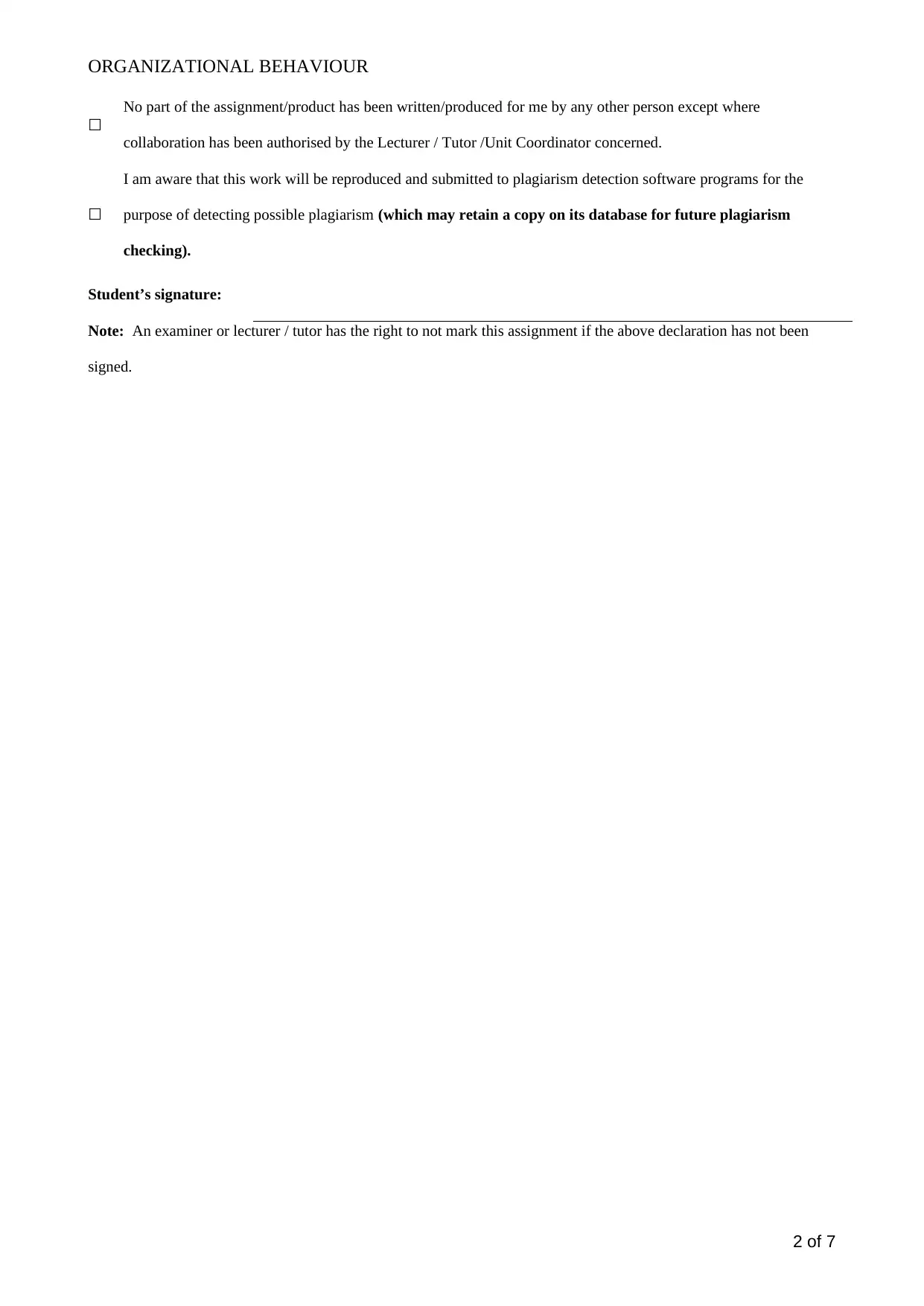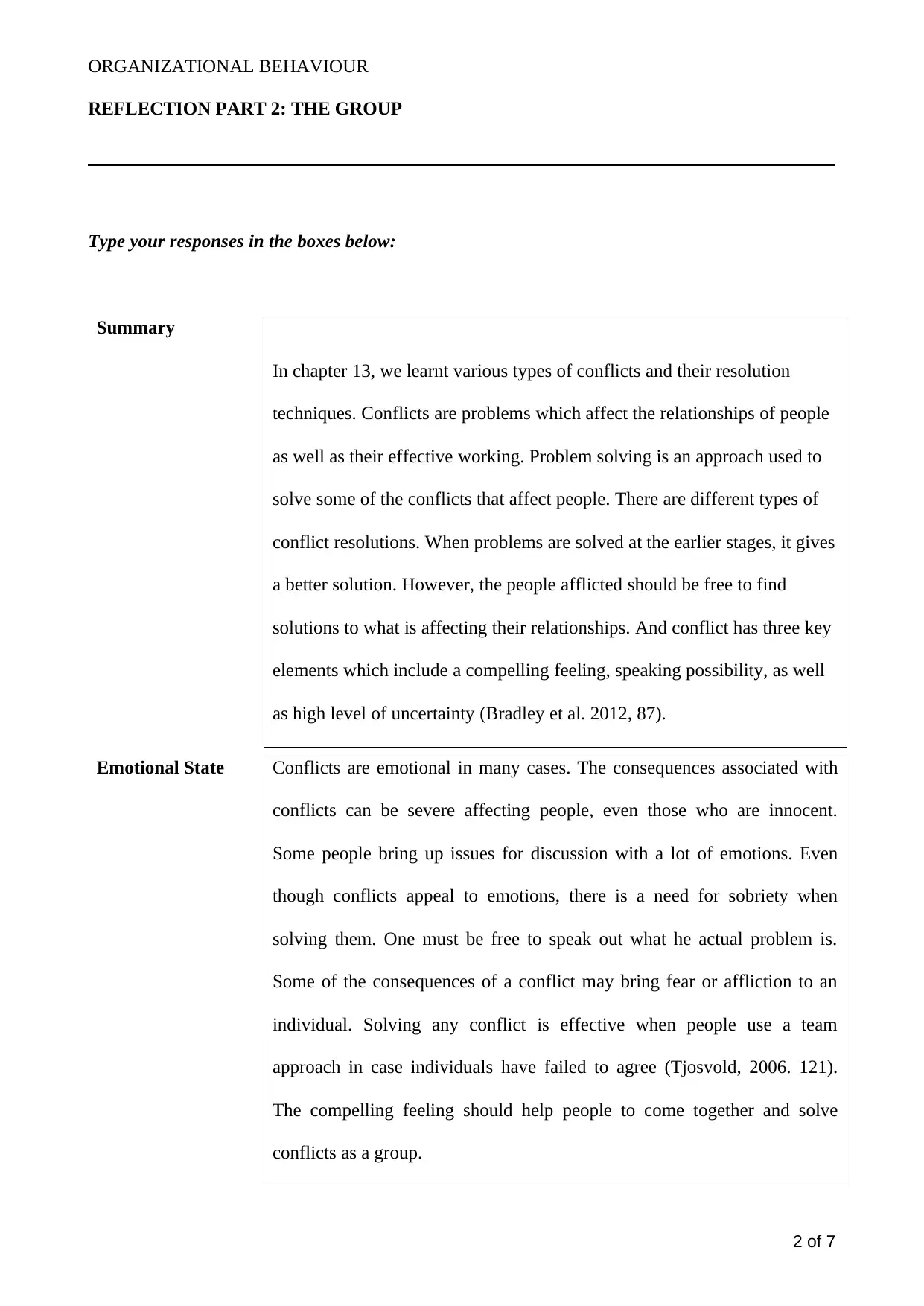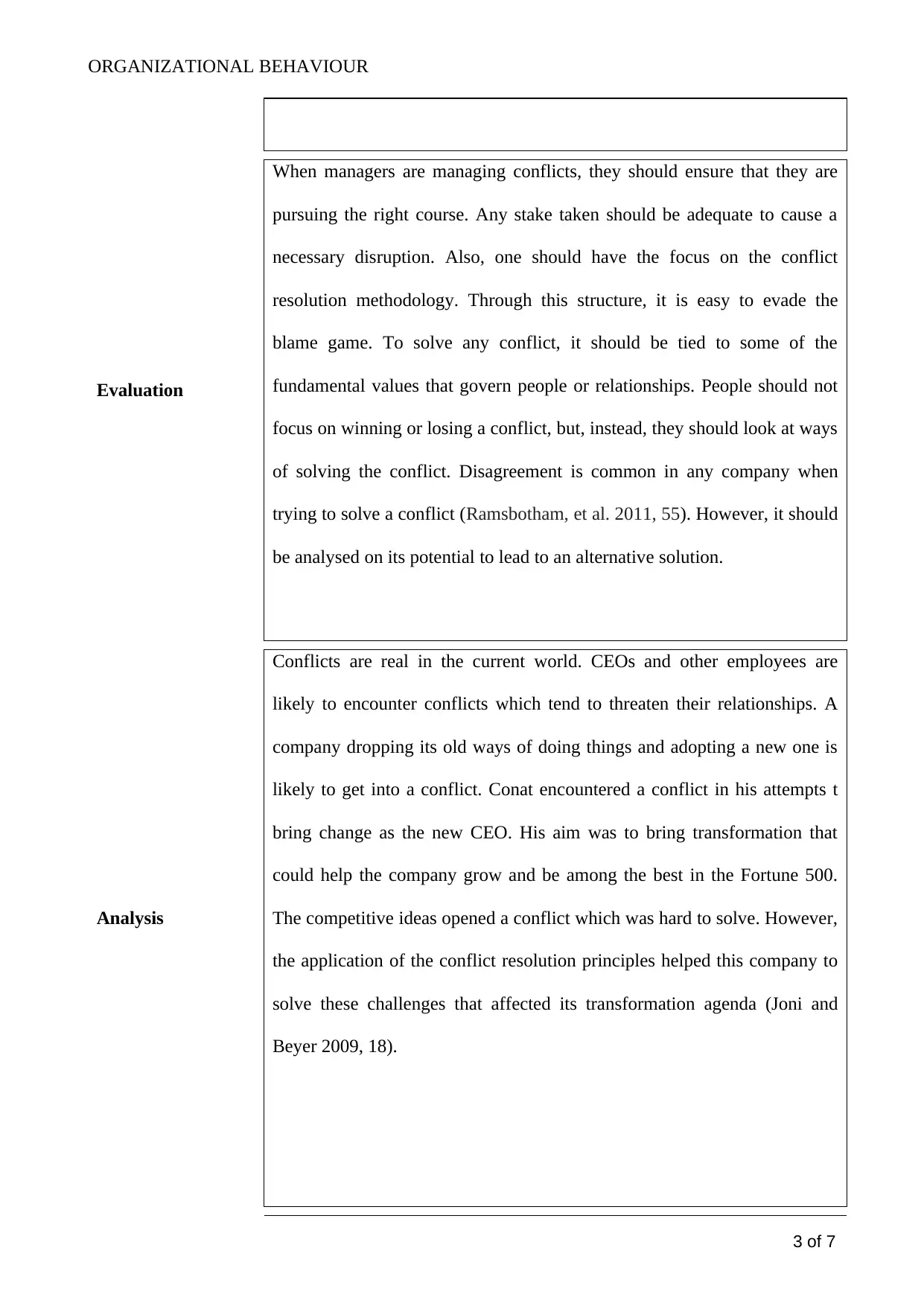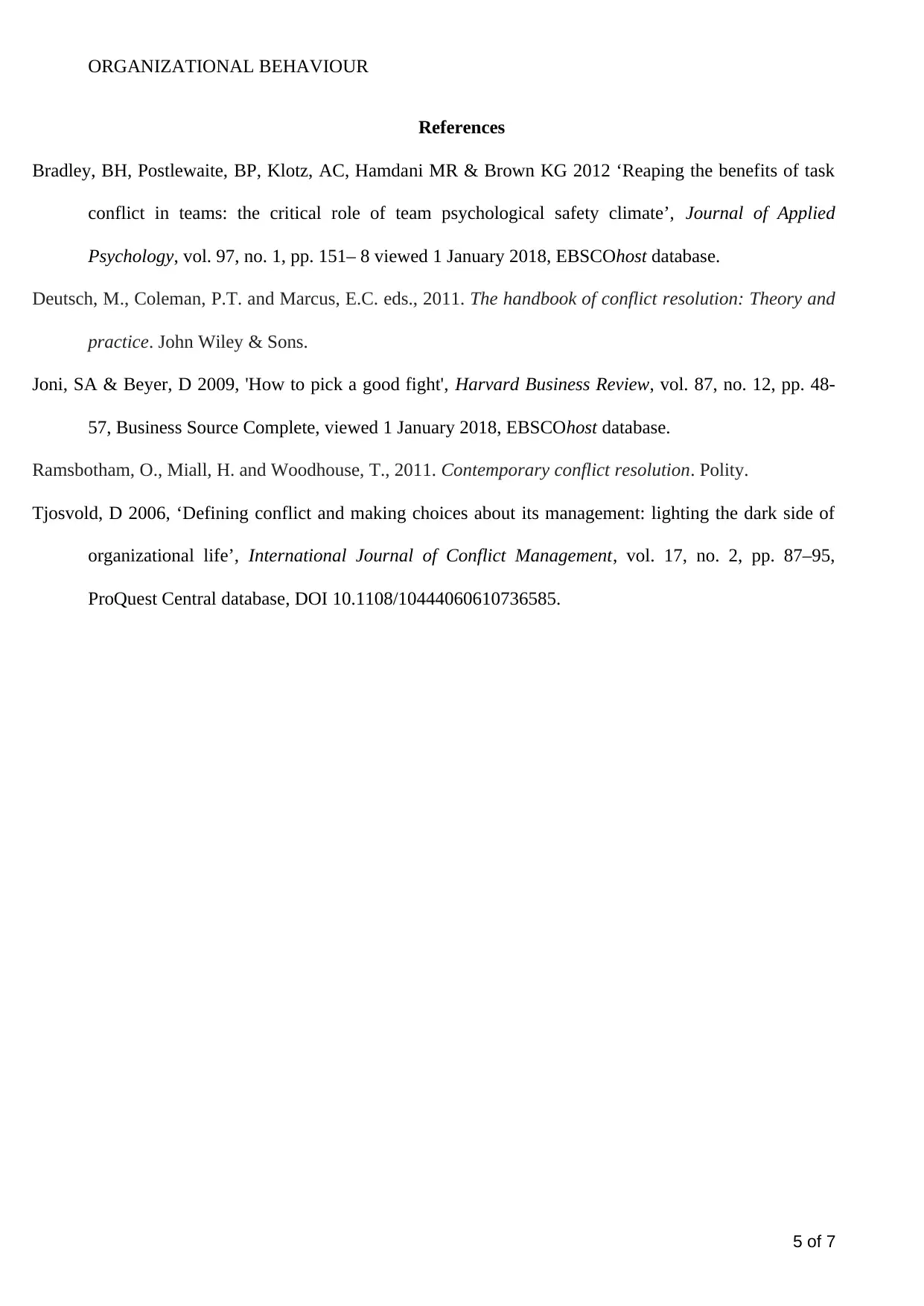Organizational Behaviour: Reflection on Group Dynamics Report
VerifiedAdded on 2023/06/11
|6
|1170
|399
Report
AI Summary
This report is a reflection on group dynamics and conflict resolution within an organizational behavior context. It highlights the importance of understanding different types of conflicts and resolution techniques, emphasizing problem-solving as a key approach. The report discusses the emotional aspects of conflicts, the need for sobriety in resolving them, and the significance of a team approach. It also touches on the role of managers in guiding conflict resolution, focusing on fundamental values, and avoiding blame games. The analysis extends to how conflicts can affect future relations and the importance of managing diverse opinions within a group to promote equality and satisfaction, ultimately preventing further conflicts. The report references various academic sources to support its claims and recommendations.

ORGANIZATIONAL BEHAVIOUR
SCHOOL OF BUSINESS
ASSIGNMENT COVER SHEET
STUDENT DETAILS
Student name: Student ID number:
UNIT AND TUTORIAL DETAILS
Unit name: Unit number:
Tutorial group: Tutorial day and time:
Lecturer or Tutor name:
ASSIGNMENT DETAILS
Title: REFLECTION PART 2: THE GROUP
Length: Due date: Date submitted:
Home campus (where you are enrolled):
DECLARATION
☐ I hold a copy of this assignment if the original is lost or damaged.
☐
I hereby certify that no part of this assignment or product has been copied from any other student’s work or from
any other source except where due acknowledgement is made in the assignment.
☐
I hereby certify that no part of this assignment or product has been submitted by me in another (previous or
current) assessment, except where appropriately referenced, and with prior permission from the Lecturer /
Tutor / Unit Coordinator for this unit.
1 of 7
SCHOOL OF BUSINESS
ASSIGNMENT COVER SHEET
STUDENT DETAILS
Student name: Student ID number:
UNIT AND TUTORIAL DETAILS
Unit name: Unit number:
Tutorial group: Tutorial day and time:
Lecturer or Tutor name:
ASSIGNMENT DETAILS
Title: REFLECTION PART 2: THE GROUP
Length: Due date: Date submitted:
Home campus (where you are enrolled):
DECLARATION
☐ I hold a copy of this assignment if the original is lost or damaged.
☐
I hereby certify that no part of this assignment or product has been copied from any other student’s work or from
any other source except where due acknowledgement is made in the assignment.
☐
I hereby certify that no part of this assignment or product has been submitted by me in another (previous or
current) assessment, except where appropriately referenced, and with prior permission from the Lecturer /
Tutor / Unit Coordinator for this unit.
1 of 7
Paraphrase This Document
Need a fresh take? Get an instant paraphrase of this document with our AI Paraphraser

ORGANIZATIONAL BEHAVIOUR
☐
No part of the assignment/product has been written/produced for me by any other person except where
collaboration has been authorised by the Lecturer / Tutor /Unit Coordinator concerned.
☐
I am aware that this work will be reproduced and submitted to plagiarism detection software programs for the
purpose of detecting possible plagiarism (which may retain a copy on its database for future plagiarism
checking).
Student’s signature:
Note: An examiner or lecturer / tutor has the right to not mark this assignment if the above declaration has not been
signed.
2 of 7
☐
No part of the assignment/product has been written/produced for me by any other person except where
collaboration has been authorised by the Lecturer / Tutor /Unit Coordinator concerned.
☐
I am aware that this work will be reproduced and submitted to plagiarism detection software programs for the
purpose of detecting possible plagiarism (which may retain a copy on its database for future plagiarism
checking).
Student’s signature:
Note: An examiner or lecturer / tutor has the right to not mark this assignment if the above declaration has not been
signed.
2 of 7

ORGANIZATIONAL BEHAVIOUR
REFLECTION PART 2: THE GROUP
Type your responses in the boxes below:
Summary
In chapter 13, we learnt various types of conflicts and their resolution
techniques. Conflicts are problems which affect the relationships of people
as well as their effective working. Problem solving is an approach used to
solve some of the conflicts that affect people. There are different types of
conflict resolutions. When problems are solved at the earlier stages, it gives
a better solution. However, the people afflicted should be free to find
solutions to what is affecting their relationships. And conflict has three key
elements which include a compelling feeling, speaking possibility, as well
as high level of uncertainty (Bradley et al. 2012, 87).
Emotional State Conflicts are emotional in many cases. The consequences associated with
conflicts can be severe affecting people, even those who are innocent.
Some people bring up issues for discussion with a lot of emotions. Even
though conflicts appeal to emotions, there is a need for sobriety when
solving them. One must be free to speak out what he actual problem is.
Some of the consequences of a conflict may bring fear or affliction to an
individual. Solving any conflict is effective when people use a team
approach in case individuals have failed to agree (Tjosvold, 2006. 121).
The compelling feeling should help people to come together and solve
conflicts as a group.
2 of 7
REFLECTION PART 2: THE GROUP
Type your responses in the boxes below:
Summary
In chapter 13, we learnt various types of conflicts and their resolution
techniques. Conflicts are problems which affect the relationships of people
as well as their effective working. Problem solving is an approach used to
solve some of the conflicts that affect people. There are different types of
conflict resolutions. When problems are solved at the earlier stages, it gives
a better solution. However, the people afflicted should be free to find
solutions to what is affecting their relationships. And conflict has three key
elements which include a compelling feeling, speaking possibility, as well
as high level of uncertainty (Bradley et al. 2012, 87).
Emotional State Conflicts are emotional in many cases. The consequences associated with
conflicts can be severe affecting people, even those who are innocent.
Some people bring up issues for discussion with a lot of emotions. Even
though conflicts appeal to emotions, there is a need for sobriety when
solving them. One must be free to speak out what he actual problem is.
Some of the consequences of a conflict may bring fear or affliction to an
individual. Solving any conflict is effective when people use a team
approach in case individuals have failed to agree (Tjosvold, 2006. 121).
The compelling feeling should help people to come together and solve
conflicts as a group.
2 of 7
⊘ This is a preview!⊘
Do you want full access?
Subscribe today to unlock all pages.

Trusted by 1+ million students worldwide

ORGANIZATIONAL BEHAVIOUR
Evaluation
When managers are managing conflicts, they should ensure that they are
pursuing the right course. Any stake taken should be adequate to cause a
necessary disruption. Also, one should have the focus on the conflict
resolution methodology. Through this structure, it is easy to evade the
blame game. To solve any conflict, it should be tied to some of the
fundamental values that govern people or relationships. People should not
focus on winning or losing a conflict, but, instead, they should look at ways
of solving the conflict. Disagreement is common in any company when
trying to solve a conflict (Ramsbotham, et al. 2011, 55). However, it should
be analysed on its potential to lead to an alternative solution.
Analysis
Conflicts are real in the current world. CEOs and other employees are
likely to encounter conflicts which tend to threaten their relationships. A
company dropping its old ways of doing things and adopting a new one is
likely to get into a conflict. Conat encountered a conflict in his attempts t
bring change as the new CEO. His aim was to bring transformation that
could help the company grow and be among the best in the Fortune 500.
The competitive ideas opened a conflict which was hard to solve. However,
the application of the conflict resolution principles helped this company to
solve these challenges that affected its transformation agenda (Joni and
Beyer 2009, 18).
3 of 7
Evaluation
When managers are managing conflicts, they should ensure that they are
pursuing the right course. Any stake taken should be adequate to cause a
necessary disruption. Also, one should have the focus on the conflict
resolution methodology. Through this structure, it is easy to evade the
blame game. To solve any conflict, it should be tied to some of the
fundamental values that govern people or relationships. People should not
focus on winning or losing a conflict, but, instead, they should look at ways
of solving the conflict. Disagreement is common in any company when
trying to solve a conflict (Ramsbotham, et al. 2011, 55). However, it should
be analysed on its potential to lead to an alternative solution.
Analysis
Conflicts are real in the current world. CEOs and other employees are
likely to encounter conflicts which tend to threaten their relationships. A
company dropping its old ways of doing things and adopting a new one is
likely to get into a conflict. Conat encountered a conflict in his attempts t
bring change as the new CEO. His aim was to bring transformation that
could help the company grow and be among the best in the Fortune 500.
The competitive ideas opened a conflict which was hard to solve. However,
the application of the conflict resolution principles helped this company to
solve these challenges that affected its transformation agenda (Joni and
Beyer 2009, 18).
3 of 7
Paraphrase This Document
Need a fresh take? Get an instant paraphrase of this document with our AI Paraphraser

ORGANIZATIONAL BEHAVIOUR
Conclusions &
Recommendations
Any conflict is likely to affect future relations. Thus, the approach and the
attention given to a conflict determine the reliability of its solution
(Deutsch, et al. 2011, 44). Manages should take the central position in
offering lasting solutions to internal and other organizational conflicts.
Where people are coming from diverse cultures, they are likely to have
different opinions and ways of doing things. However, when a group comes
together, they form values which govern their relationships. Winning or
losing a conflict should not be seen as the main target. However, those
people with conflict interests or ideas should be sorted out in a manner that
promotes equality and satisfaction. Through this process it is easy to avoid
further conflicts.
4 of 7
Conclusions &
Recommendations
Any conflict is likely to affect future relations. Thus, the approach and the
attention given to a conflict determine the reliability of its solution
(Deutsch, et al. 2011, 44). Manages should take the central position in
offering lasting solutions to internal and other organizational conflicts.
Where people are coming from diverse cultures, they are likely to have
different opinions and ways of doing things. However, when a group comes
together, they form values which govern their relationships. Winning or
losing a conflict should not be seen as the main target. However, those
people with conflict interests or ideas should be sorted out in a manner that
promotes equality and satisfaction. Through this process it is easy to avoid
further conflicts.
4 of 7

ORGANIZATIONAL BEHAVIOUR
References
Bradley, BH, Postlewaite, BP, Klotz, AC, Hamdani MR & Brown KG 2012 ‘Reaping the benefits of task
conflict in teams: the critical role of team psychological safety climate’, Journal of Applied
Psychology, vol. 97, no. 1, pp. 151– 8 viewed 1 January 2018, EBSCOhost database.
Deutsch, M., Coleman, P.T. and Marcus, E.C. eds., 2011. The handbook of conflict resolution: Theory and
practice. John Wiley & Sons.
Joni, SA & Beyer, D 2009, 'How to pick a good fight', Harvard Business Review, vol. 87, no. 12, pp. 48-
57, Business Source Complete, viewed 1 January 2018, EBSCOhost database.
Ramsbotham, O., Miall, H. and Woodhouse, T., 2011. Contemporary conflict resolution. Polity.
Tjosvold, D 2006, ‘Defining conflict and making choices about its management: lighting the dark side of
organizational life’, International Journal of Conflict Management, vol. 17, no. 2, pp. 87–95,
ProQuest Central database, DOI 10.1108/10444060610736585.
5 of 7
References
Bradley, BH, Postlewaite, BP, Klotz, AC, Hamdani MR & Brown KG 2012 ‘Reaping the benefits of task
conflict in teams: the critical role of team psychological safety climate’, Journal of Applied
Psychology, vol. 97, no. 1, pp. 151– 8 viewed 1 January 2018, EBSCOhost database.
Deutsch, M., Coleman, P.T. and Marcus, E.C. eds., 2011. The handbook of conflict resolution: Theory and
practice. John Wiley & Sons.
Joni, SA & Beyer, D 2009, 'How to pick a good fight', Harvard Business Review, vol. 87, no. 12, pp. 48-
57, Business Source Complete, viewed 1 January 2018, EBSCOhost database.
Ramsbotham, O., Miall, H. and Woodhouse, T., 2011. Contemporary conflict resolution. Polity.
Tjosvold, D 2006, ‘Defining conflict and making choices about its management: lighting the dark side of
organizational life’, International Journal of Conflict Management, vol. 17, no. 2, pp. 87–95,
ProQuest Central database, DOI 10.1108/10444060610736585.
5 of 7
⊘ This is a preview!⊘
Do you want full access?
Subscribe today to unlock all pages.

Trusted by 1+ million students worldwide
1 out of 6
Related Documents
Your All-in-One AI-Powered Toolkit for Academic Success.
+13062052269
info@desklib.com
Available 24*7 on WhatsApp / Email
![[object Object]](/_next/static/media/star-bottom.7253800d.svg)
Unlock your academic potential
Copyright © 2020–2025 A2Z Services. All Rights Reserved. Developed and managed by ZUCOL.





